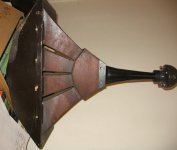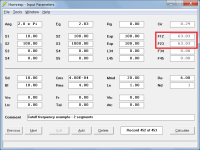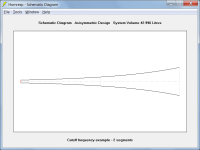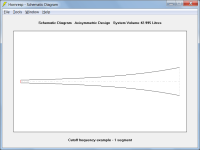Is it there on your system? Maybe some other application installed it - MSOffice, for instance.That's interesting. Because I am running windoz 10 and I never installed the font.
Would it be possible to model a multicell horn based on a standard exponential horn lenght and mouth surface ?
As David explained, the power response would be effectively the same. The power response is calculated from the throat impedance (for a given driver etc), and the throat impedance again depends mainly on the area expansion through the horn.
The directivity would be different, but I think Olson found that the directivity of a multicell horn can be approximated by a curved line source. And I think that is also the directivity model Hornresp uses for conical horns. So you can probably simulate the directivity of the multicell using a conical horn defining the same arc as the mouth of the multicell horn.
Since the pressure response equals power response + directivity index, you can calculate the directivity index of this conical horn and add to the power response of the exponential horn that represents the multicell horn. That would then give you the frequency response at the angle you calculated the DI. It looks like this has to be done externally to Hornresp, for instance by exporting the results. I'm not sure if DI can be exported, though. David?
I came across this 3d printable model of a 15 cells horn.
https://www.thingiverse.com/thing:4965272
Looks like it was designed by Pelanj who posted in reply to my question a few posts above (this is a small world).
According to Pelanj description, this horn has a crossover point of 500hz.
Now I wonder if it can be lowered to 2-300 by extending the adapter
I have studied the Altec catalog attached, and they managed to reach 300hz with a lenght of about 26" (model 803B and 1003B)
hence the idea to extend Pelanj horn adapter to achieve the desired low end response.
With regards to the driver, it would be interesting to understand if such horn can be equipped with the celestion 5" cone driver I modeled my previous mid bass horn upon, as it resulted in a beautiful linesr and extended response across the intended range.
https://www.thingiverse.com/thing:4965272
Looks like it was designed by Pelanj who posted in reply to my question a few posts above (this is a small world).
According to Pelanj description, this horn has a crossover point of 500hz.
Now I wonder if it can be lowered to 2-300 by extending the adapter
I have studied the Altec catalog attached, and they managed to reach 300hz with a lenght of about 26" (model 803B and 1003B)
hence the idea to extend Pelanj horn adapter to achieve the desired low end response.
With regards to the driver, it would be interesting to understand if such horn can be equipped with the celestion 5" cone driver I modeled my previous mid bass horn upon, as it resulted in a beautiful linesr and extended response across the intended range.
Attachments
Thanks! Found it!It is possible to export the horn data as a .txt file, which can then be converted to .csv and then imported into Excel (or other software).
The export function is available from Window-->Schematic Diagram then go to File -->Export-->Horn Data.
Choose the type of profile among those available (rectangular etc.) and export data. You can preview the profile before exporting.
Several CAD softwares have a function (or plugin) to import .csv values as points which you can connect to ricreate the profile.
Yes if I have the data in CSV form I can import it to many CAD programs.
Cheers!
@Gumbo Have you seen this thread: https://www.diyaudio.com/community/threads/the-construction-of-a-multicell-horn.136964/
There is a lot of useful information.
There is a lot of useful information.
I have seen that thread, unfortunately all the pics are missing.
I have some questions regarding your design.
What is the actual crossover point of you 3d printable horn and how long is it ?
What is the throat surface (lenght x width) of the multicell, without adapter. I need this data to evaluate at what lenght I should "cut" my horn to fit it into your multicell design.
Attached below a pioneer horn with a long adapter, which is basically what I am planning to do, in order to.make your horn usable down to 2-300hz. Mine will probably be longer.
https://www.
I have some questions regarding your design.
What is the actual crossover point of you 3d printable horn and how long is it ?
What is the throat surface (lenght x width) of the multicell, without adapter. I need this data to evaluate at what lenght I should "cut" my horn to fit it into your multicell design.
Attached below a pioneer horn with a long adapter, which is basically what I am planning to do, in order to.make your horn usable down to 2-300hz. Mine will probably be longer.
https://www.
Attachments
Last edited:
I'm not sure if DI can be exported
Not at the moment, but hopefully after the next update.
The raw DI data will be exported, leaving it to the user to decide how best to use it.
I am not sure I understand this statement.With an exponential profile, if the throat area, mouth area and length of a single cell are entered, then the flare cutoff frequency of that cell will be the same as for the total system.
How can a single, small cell have the same flare cutoff frequency of the whole array of cells ?
This seems to contradict your previous statement that "the power response should be effectively the same".
I probably misunderstood what you mean.
Based on your and Kolbrek's explanation that:
- terminating the horn with or without a multicell is irrelevant to the power output and that a multicell can be designed as an array of "scaled down versions" of the "large" horn
- it is irrelevant wether the multicell section takes only a part of the overall lenght
I believe I may as well design my own multicell instead of trying to combine Pelanj multicell section to the first half of my horn (or at least compare Pelanj cells shape to that of my own).
Is this conclusion correct ?
How can a single, small cell have the same flare cutoff frequency of the whole array of cells ?
The flare cutoff frequency of an exponential horn is given by:
F12 = c * ln(S2 / S1) / (4 * Pi * L12)
Where:
F12 = flare cutoff frequency
c = speed of sound
S1 = throat cross-sectional area
S2 = mouth cross-sectional area
L12 = axial length
ln(S2 / S1) = natural logarithm of S2 / S1
If L12 is constant then the value of F12 will simply depend upon the ratio of S2 / S1. If the ratio doesn't change then neither will the cutoff frequency.
Assume that a single large horn has the dimensions S1 = 100, S2 = 1000 and L12 = 100, so that ratio of S2 / S1 equals 1000 / 100 or 10:1.
Now assume that the same-sized horn has 10 cells, making the dimensions of each cell S1 = 10, S2 = 100 and L12 = 100, so that ratio of S2 / S1 equals 100 / 10 or 10:1, the same as for the single large horn.
The ratio of S2 / S1 hasn't changed, so the cutoff frequency of each individual cell is the same as that for the large horn.
This can be clearly seen in Attachment 1 where segment 1 has the dimensions of a single cell and segment 2 has the dimensions of the large horn. The cutoff frequencies of both segments are the same. Attachment 2 shows the schematic for the two-segment horn, which as expected is identical to the one for a single-segment horn having S1 = 10, S2 =1000 and L12 = 200, as shown in Attachment 3.
(The 0.001 litres difference in volume between the one-segment and two-segment horns is simply due to the rounding of the individual segment volumes in the two-segment horn).
This seems to contradict your previous statement that "the power response should be effectively the same".
The power response of the multicell horn system is effectively the same as that for the equivalent single large horn. The power response of a single cell in isolation will of course be quite different, because of its much smaller physical dimensions.
a multicell can be designed as an array of "scaled down versions" of the "large" horn
Just to clarify, only the cross-sectional areas are "scaled down", the axial length is not.
it is irrelevant wether the multicell section takes only a part of the overall lenght
As far as the power response is concerned, yes.
Is this conclusion correct ?
Yes.
Attachments
David I read your answer a few times, watched the attachments, and I guess I need a clarification. Bear with me if I ask stupid questions.
Re: the small single cell has same cutoff frequency (F12) of the large horn with same profile.
I always believed (and was taught in this same thread) that the low cutoff frequency (the lower frewuency which can be effectively reproduced by a horn) is strictly related to the horn mouth surface in relation to the wavelength.
Based on this I well understand how an array of small horns combined to form a mouth surface of 1000 can reproduce the same low frequency of a single horn with the same mouth surface.
The surface is still 1000 and so the wavelength is the same.
What I dont understand is how is it possible that one of those small cell has the same F12 value of a larger one. Since the mouth is smaller the wavelength that the single cell should be able to reproduce should be much shorter (higher frequency).
Perhaps the F12 value is not related to the actual lower frequency which can be reproduced by a given horn ?
On a less theoretical and more empirical basis. The horn I designed is not really exponential, it is a cosh horn. You mentiined in a previous post that the equivalence we are discussing only applies to exponential horns.
I am aware how cosh horns share several traits with exponentials, still I wonder if the multicell to single cell equivalence can also be applied to cosh horns.
Re: the small single cell has same cutoff frequency (F12) of the large horn with same profile.
I always believed (and was taught in this same thread) that the low cutoff frequency (the lower frewuency which can be effectively reproduced by a horn) is strictly related to the horn mouth surface in relation to the wavelength.
Based on this I well understand how an array of small horns combined to form a mouth surface of 1000 can reproduce the same low frequency of a single horn with the same mouth surface.
The surface is still 1000 and so the wavelength is the same.
What I dont understand is how is it possible that one of those small cell has the same F12 value of a larger one. Since the mouth is smaller the wavelength that the single cell should be able to reproduce should be much shorter (higher frequency).
Perhaps the F12 value is not related to the actual lower frequency which can be reproduced by a given horn ?
On a less theoretical and more empirical basis. The horn I designed is not really exponential, it is a cosh horn. You mentiined in a previous post that the equivalence we are discussing only applies to exponential horns.
I am aware how cosh horns share several traits with exponentials, still I wonder if the multicell to single cell equivalence can also be applied to cosh horns.
Regarding how a small cell can have the same F12 as a larger one.
F12 is the theoretical cutoff frequency of an exponential horn having a certain rate of expansion (flare rate). It is calculated from the horn dimensions using the equations given by David.
These equations do not evaluate how well the horn performs in practice, the effects of the mouth size in terms of wavelengths etc. You could call F12 the flare frequency of the horn; it determines how quickly the horn flares based on the following equations:
S(x) = S1 * exp(m*x)
where
m = 4*pi*F12/c
c = speed of sound
x = distance along horn.
But the lowest frequency a horn can (efficiently) reproduce in practice is set by both the flare rate, the length of the horn, and the size of the mouth. The size of the mouth (in terms of wavelengths) determines if the wave propagating through the horn will be able to radiate efficiently, or be partially or nearly fully reflected. In this case, the size of the mouth should be the effective size, i.e. the total area of all the cells radiating, and the acoustic mirror images from nearby walls etc. The length of the horn (in terms of wavelengths) determines if the horn is long enough to do it's job as an impedance transformer, or if it's so short that it will behave merely as a discontinuity and added air mass. Then you have the interaction with the driver, which is yet another factor.
When you look at the equations David gave, you can see there is no comparison between the mouth size (S2) and the cutoff frequency, or between the length of the horn and the cutoff frequency.
If by cosh horn you mean a Hypex horn with T < 1, the equivalence still applies. The cutoff frequency is still calculated based on the S2/S1 ratio, it is just that the T factor enters the mix.
F12 is the theoretical cutoff frequency of an exponential horn having a certain rate of expansion (flare rate). It is calculated from the horn dimensions using the equations given by David.
These equations do not evaluate how well the horn performs in practice, the effects of the mouth size in terms of wavelengths etc. You could call F12 the flare frequency of the horn; it determines how quickly the horn flares based on the following equations:
S(x) = S1 * exp(m*x)
where
m = 4*pi*F12/c
c = speed of sound
x = distance along horn.
But the lowest frequency a horn can (efficiently) reproduce in practice is set by both the flare rate, the length of the horn, and the size of the mouth. The size of the mouth (in terms of wavelengths) determines if the wave propagating through the horn will be able to radiate efficiently, or be partially or nearly fully reflected. In this case, the size of the mouth should be the effective size, i.e. the total area of all the cells radiating, and the acoustic mirror images from nearby walls etc. The length of the horn (in terms of wavelengths) determines if the horn is long enough to do it's job as an impedance transformer, or if it's so short that it will behave merely as a discontinuity and added air mass. Then you have the interaction with the driver, which is yet another factor.
When you look at the equations David gave, you can see there is no comparison between the mouth size (S2) and the cutoff frequency, or between the length of the horn and the cutoff frequency.
If by cosh horn you mean a Hypex horn with T < 1, the equivalence still applies. The cutoff frequency is still calculated based on the S2/S1 ratio, it is just that the T factor enters the mix.
Perhaps the F12 value is not related to the actual lower frequency which can be reproduced by a given horn ?
F12 is a theoretical value based on the performance of an infinite horn.
For a given S1 and F12, the throat acoustical impedance will vary depending upon the value of L12 and hence S2, in the manner shown below.
I am aware how cosh horns share several traits with exponentials, still I wonder if the multicell to single cell equivalence can also be applied to cosh horns.
Yes it can, F12 remains constant.
EDIT - The important thing, as stated earlier, is that the power response of a multicell horn will be effectively the same as that of an equivalent-sized single large horn, regardless of the F12 value.
Last edited:
Regarding how a small cell can have the same F12 as a larger one.
I was too busy working on my own post, to see that you had already responded
Hi,
I've been Looking for 2h how to simulate a BP6 enclosure and i still can't find the solution. The BP6 isn't shown in the speaker type choices (where it should be written in Red) and the other solutions i've read don't work for me (i literally copy everything and it gives me errors cause the S3 is at 0, and i can't change anything).
Is there something i missed (i've used it only to sim TH and MLTL enclosures, i'm still new at it)?
I'm sorry to have to ask this topic for this question and sorry for my maybe poor english.
Thanks a lot if you can help me.
I've been Looking for 2h how to simulate a BP6 enclosure and i still can't find the solution. The BP6 isn't shown in the speaker type choices (where it should be written in Red) and the other solutions i've read don't work for me (i literally copy everything and it gives me errors cause the S3 is at 0, and i can't change anything).
Is there something i missed (i've used it only to sim TH and MLTL enclosures, i'm still new at it)?
I'm sorry to have to ask this topic for this question and sorry for my maybe poor english.
Thanks a lot if you can help me.
I've been Looking for 2h how to simulate a BP6 enclosure and i still can't find the solution.
1. From the main Input Parameters window select menu commands Help > Input Wizard.
2. From the Input Wizard tool select options Half space > Direct radiator > Band pass > Sixth order series (or Sixth order parallel).
David and Bjorn, for president !!!
For us, that would have to be Prime Minister rather than President
Could Hornresp be used or updated to sim an Augmented Passive Radiator alignment? I've always been curious about those, after having read about them in the Loudspeaker Design Cookbook. However I've never seen any actually built, DIY or commercial, and I suspect that a sim of their capabilities might help to indicate why.
The augmented passive radiator (APR) alignment shown in the Vance Dickason Loudspeaker Design Cookbook cannot currently be simulated in Hornresp, and for all sorts of reasons, it's not going to happen. I suspect that it could even be a challenge to model the system in AKABAK due to the requirement for two mechanically-connected passive radiators.
- Home
- Loudspeakers
- Subwoofers
- Hornresp



